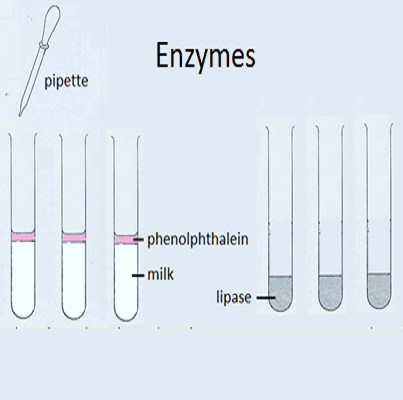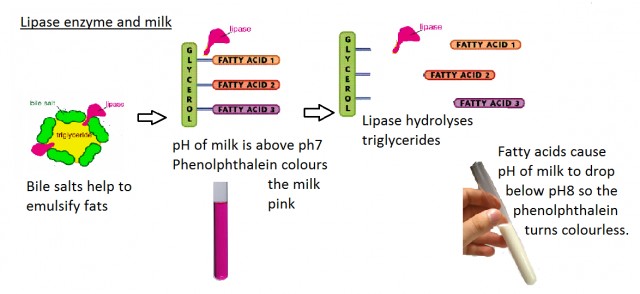IA Lipase Experiment

Enzymes experiment using lipase and milk.
This lesson is an opportunity to complete some IA skills training. Students will have studied enzymes in the Biochemistry topic and so they will hopefully perform well in this IA. It links nicely to the annotations of the functions of the parts of the digestive system and to the diagrams and the names and roles of different enzymes required.
Lesson Description
Guiding Questions
What factors affect the rate of an enzyme reaction?
How can we use the end point of a reaction to show us the rate of an enzyme reaction?
Activity 1 How can a pH indicator like phaenolphthalein show the rate of reaction.
Revision of the structure of lipids (triglycerides) and some information about the lipids in milk.
Explanation of the colours which the indicator phenolpthalein turns.
A demo of acid alkali and neutral conditions with the indicator is a good idea.
The substrate and products of lipase enzymes also needs explaining.

Activity 2: Experiment to measure the rate of lipase activity in milk.
Carry out the experiment on the ![]() Digestive enzyme (lipase) worksheet below.
Digestive enzyme (lipase) worksheet below.
Activity 3 Other enzymes
Research the enzymes which digest carbohydrates, proteins and lipids in the human digestive system. These are Amylase, Endopeptidase and Lipase respectively.
- Find out what the role of bile salts is exactly in the digestion of lipids?
- What are the optimum conditions for the enzymes amylase and endopeptidase? Are they the same?
Teachers notes
An introduction to this experiment is quite important otherwise students may not understand the role of lipase enzymes, nor the way the phenolphthlalein indicates the production of fatty acids.
The experiment worksheet allows students to practice being assessed on Ex and An as an IA practice.
One weakness of this experiment is that the pH will be different in different samples of milk. So best to complete all the samples on the same day. It may be necessary to add a little bicarbonate solution to the milk before starting if the indicator isn't pink at the start. As the enzymes hydrolyse the triglycerides acids released lower the pH.
An alternative way to measure the rate in this reaction could be to use pH meters in place of the indicator.
In time activity three will be a sheet of some questions about optimum conditions for different enzymes at different places in the digestive system.

 IB Docs (2) Team
IB Docs (2) Team
